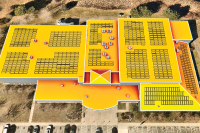Landslide hazard maps axed by state: Risky slopes in Jackson, Haywood to remain a mystery for now
Republican lawmakers have pulled the plug on the state’s landslide mapping unit, terminating a controversial project to assess which slopes in the mountains are landslide prone.
A team of five state geologists working on the maps are being laid-off this week, saving the state $355,000 a year.
“They are very disappointed as we all are. We felt this was important work from the perspective of public safety that had a lot of value, and we are disappointed we couldn’t complete it,” said Rick Wooten, a senior state geologist and landslide expert based in Asheville.
When the team was created in 2005, their mission was to map landslide hazards in every mountain county. The team only finished four counties: Macon, Buncombe, Henderson and Watauga.
The unit was working on Jackson County when it halted in its tracks.
“I thought it was an added benefit and I was glad we were at the front end of it,” said Tom Massie, an advocate for landslide mapping in Jackson County who serves on the Mountain Resources Commission. “Anyone getting ready to buy a piece of property or build a home would know whether it was a suitable site. Now they are going to have to proceed at their own risk.”
Related Items
Haywood County was next in line, but won’t being seeing its landslide maps either.
“I feel like we will be losing a valuable tool in the planning process for the land that is left to develop in Haywood County,” said Marc Pruett, an erosion control officer in Haywood County.
Landslide mapping has proven controversial, however. Critics fear the stigma of being in landslide hazard zones would make property hard to sell or develop.
“Certainly some of the legislators have been very open in their statements that they viewed these maps as a backdoor to regulation and were not the least bit sorry to see these maps go away,” said DJ Gerken, and Asheville-based attorney with the Southern Environmental Law Center.
That begs the question as to whether it was truly budget concerns and cost-savings that prompted lawmakers to target the landslide mapping. Indeed, environmental policies and funding have taken a big hit under the Republican controlled legislature. (See related story in Outdoors section.)
Rep. Mitch Gillespie, R-Marion, said landslide mapping was killed to save money — not because of an ideological stance.
“We had to make cuts throughout government this year and one of the areas that I didn’t feel like was a ‘have-to’ thing was the landslide mapping program,” Gillespie said.
But, Gillespie makes no bones about it: the state shouldn’t meddle in steep slope regulations. And Gillespie indeed feared the landslide maps would become ammunition to push through slope construction laws at the state level.
“That’s what they were doing it for,” Gillespie said of the landslide maps.
Sen. Jim Davis, R-Franklin, said he fielded a call from emergency responders in Haywood County — where several homes have been hit by landslides in the past decade — asking him not to cut the program. The landslide team was always one of the first on the scene when slides struck.
“Our role was to help out the emergency managers figure out what happened. Is it safe to work around here? Is there still unstable material up here? If there is, where might it go? Do we need to evacuate people? When is it safe to go back?” Wooten said.
If the state had plenty of money, Davis can’t say what the fate of the landslide mapping unit would have been.
“To be perfectly candid, I don’t know. That is a different conversation. Since we didn’t have the money we didn’t get to that conversation,” said Davis.
Good riddance
Not everyone is sad to see landslide maps fall by the wayside. Lamar Sprinkle, a surveyor in Macon County and a member of the planning board, said he feels like Macon is penalized as one of the four counties to have completed maps.
“As a property owner I would think if my property lay in one of these zones, it would devalue my property,” Sprinkle said.
Sprinkle said a prospective buyer from out of state would likely be turned off from property that falls in landslide zone, without knowing exactly what that meant.
“If I went down to the coast and there was some kind of red flag throwed up to me that I didn’t totally understand, I probably wouldn’t buy that piece of property,” Sprinkle said.
Sprinkle said he doesn’t understand how the maps were arrived at and is hesitant to take them at face value. He said the maps are a knee-jerk reaction to the Peek’s Creek tragedy. While a tragedy indeed, Sprinkle believes it was a random act of God. He sees landslide mapping as an arbitrary and fruitless endeavor that will do little to actually predict where a slide might hit in the future.
“There are some things we don’t have any control over,” Sprinkle said.
In wind storms, trees have fallen on homes, one even killing a couple inside.
“You don’t go passing an ordinance to make everybody cut the trees around their house,” Sprinkle said.
Ron Winecoff of ReMax Elite Realty in Franklin said Macon would be better off without the maps. He, too, fears it could devalue property.
Winecoff said Realtors in Macon have been confused over whether they are obligated to tell prospective buyers when property falls in the landslide hazard zone. Do the same rules apply as lead paint or asbestos? For now, the answer is no, supposedly.
“The state board of Realtors has told us we do not have to disclose it and so we don’t disclose it, but I don’t know whether that is right or not,” Winecoff said. “If you are aware of it, any item that effects the property adversely needs to be disclosed. Technically probably we should be disclosing those maps because they do exist.”
Critics of landslide mapping fear that property undeserving of such a label would be blacklisted and become impossible to sell.
More often that not, however, the landslide mapping would help people figure out where on a lot to put a house. Landslides follow predictable paths down the mountains, and building outside that path is usually all that is needed, say experts.
The path of a landslide is about 60 feet wide — about 30 feet to each side of the natural drainage course.
Gerken pointed to the Peek’s Creek disaster in Macon County, where 15 homes were destroyed in 2005. Those built closer to the drainage were flattened while those 10 yards to the side survived intact.
That’s why Pruett sees the landslide maps as a planning tool.
“If you had a chance to buy a piece of property and you knew where there might be a hazardous spot, wouldn’t you want to move your house 50 feet away from it? How could that not be helpful?” Pruett said.
There is, no doubt, some property in the mountains simply too steep, too unstable and too prone to landslides to build on — as unfortunate as that may be for the person who owns it and would like to sell it, Pruett said.
“Sometimes you just have to look a bear in the face and say it is a bear,” Pruett said.
But the landslide maps shouldn’t be blamed for pointing out the obvious.
While the homebuilders and real estate groups have actively lobbied against the landslide maps at the state level, not all developers are against them.
Ben Bergen, a builder in Jackson County and board member on the local Homebuilders Association, thinks the maps would have been a good tool.
“We would have liked to see it through to completion,” said Bergen, owner of the green building firm Legacy. “North Carolina is a buyer beware state in terms of property. I agree it is up to the buyer to inform themselves, but I thought it was going to very useful as a builder.”
At the very least, the maps would alert people to buy supplemental landslide insurance, Massie said. Regular homeowners insurance doesn’t cover landslides. Homeowners are out of luck — whether a home is totally flattened or the foundation destabilized due to shifting soil. They can’t sell their home, nor will insurance compensate them. Meanwhile, they have to keep paying the mortgage on a house they can’t live in. Often, bankruptcy and foreclosure become the only option.
The state has taken pity on some landslide victims and bailed them out. The state spent $3.2 million to buy out damaged areas of the Peek’s Creek slide in macon County.
Meanwhile, fixing a landslide in Maggie Valley cost the state and federal government a combined $1.4 million.
Gerken said the cost of landslide mapping would pay for itself by avoiding such disasters.
“It is an extremely affordable investment to avoid those costs,” Gerken said.
Gerken equated it to floodplain mapping, a long-standing practice that curtails building in flood-prone areas.
“Not because they happen every year, but it doesn’t make sense to build structures in an area that will likely get hit every hundred years,” Gerken said.
The maps aren’t exactly sweeping indictments of every steep mountainside. In Macon County, 11 percent of the county falls in the high landslide hazard zone. In Buncombe, its 10 percent, and just 6 percent in Henderson. Watauga comes in higher with 20 percent.
How to map a landslide
Unlike lightning, landslides nearly always strike in the same place twice. Mapping old slides is the single biggest indicator of where future slides will occur.
Many of the homes destroyed in slides over the past decade were built on top of old landslide deposits — something that landslide mapping could have warned people about, Wooten said.
“Some landslide deposits go back hundreds of thousands of years. They are usually quite large because they are an accumulation of many landslides that occur over geologic time,” Wooten said.
Wooten’s team has entered 3,000 old landslides in the state’s database so far. There are thousands more out there.
The mapping falls short of being able to predict the next slide, however.
“People say, ‘Well, where is it going to happen next time,’” Wooten said. “Eventually over geologic time it is going to reoccur.”
Geologists rely most heavily, however, on aerial photography over several decades to find evidence of slides, which remain visible for years.
In Jackson County, aerial photography from the early 1950s still revealed slides dating back to 1940, a fateful year when 13 inches of rain fell in 24 hours, triggering thousands of slides across the region.
Robbie Shelton, Jackson County’s erosion officer, was one of the team’s go-to consultants. He often acted as a guide, helping the team scout their way up mountainsides using locally known dirt roads and cart paths to reach an old slide.
After tagging along on the ground reconnaissance missions, Shelton knows what to look for and can hopefully warn builders and developers even though the county won’t have a complete map.
“I feel like I have a little better handle on it, having been out with Rick and his team, to be able to say, ‘This might not be the best place for you to think about building and you might want to consult a geotech,’” Shelton said.
The landslide unit has been working frantically to get the Jackson County maps to a good stopping point, and enter all the data they have so far into the database.
Wooten said he will drop off whatever GIS files they have done with Jackson County sometime next week, and then formally shut the books on the project.
While interesting, the half-finished map of where old landslides occurred is only somewhat helpful. The most important step — translating the location of old slides to identify low, moderate and high hazard zones — hasn’t been done.
While Wooten will remain employed as a state geologist and landslide expert, he won’t be finishing up the maps on his own.
“The message from the legislature was they do not want the mapping done,” Wooten said.
Putting the maps to work
So far, no county has banned building outright in high hazard landslide zones. What’s more likely is that landslide hazard zones will pinpoint where to impose regulations.
But of the four counties that were mapped, only Buncombe has actually done anything with them. In Henderson and Watauga, the landslide maps have found a cozy home on the shelf with no sign of being taken down anytime soon.
In Macon County, planners hope the landslide map will be incorporated into a new steep slope ordinance currently in the works. If passed by county commissioners, Macon will join just half a dozen WNC counties with slope ordinances — ranks that also include Haywood, Jackson and Buncombe.
Macon’s ordinance sets out a few simple parameters, like limiting the height and steepness of cut-and-fill slopes. On the steepest slopes, builders would have to consult an engineer.
And that’s where the landslide maps come in. Areas that fall in moderate to high landslide hazard zones would also require engineers to build on.
Wooten said that is a reasonable application for the landslide maps.
“If you were looking for a place to buy and the maps were available, you could see areas where there is a high landslide potential that would give you the information to seek additional help from geologists or engineers,” Wooten said.
But Sprinkle, who sits on the Macon planning board, doesn’t think the landslide maps have a place in the county’s ordinance, questioning their accuracy. And now that the landslide mapping team is dismantled, who can they call if they find an error in the maps, Sprinkle asked.
“There are lot of pitfalls in having maps with nobody to look after them,” Sprinkle said.
What’s next
While landslide mapping is gone for now, future lawmakers could start it back up. But a team will have to be re-assembled and the learning curve repeated.
“We paid to develop a lot of expertise in landslide mapping that we are now throwing to the wind,” Gerken said.
Landslide mapping gained traction following two back-to-back tropical storms that dumped a massive amount of rain on the mountains in 2005, triggering dozens of landslides. The most tragic was Peek’s Creek in Macon County, where five people, including a child, were killed and 15 homes destroyed.
“That was probably the event that got the attention of legislators,” Wooten said.
Gerken said the loss of life is inevitable without a more cautionary approach to siting homes.
“This short-term political decision simply cannot hold because we are going to see the consequences again,” Gerken said. “These kinds of events are part of mountain geology, and they will happen again. It is only a matter of time.”
See the maps online
To see Macon County’s landslide map, go to www.geology.enr.state.nc.us/Landslide_Info/MaconCounty.html. A partial map for Jackson will eventually be posted with a link at wfs.enr.state.nc.us/fist/.













